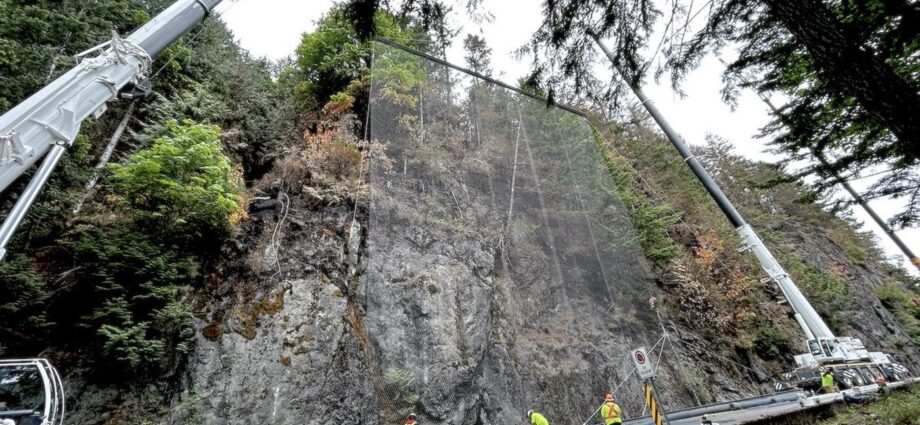
By Rochelle Baker, Local Journalism Initiative Reporter, Canada’s National Observer
June 26, 2026
British Columbia’s enormous effort to speed the partial reopening of Highway 4 on Vancouver Island — closed for upwards of two weeks due to a wildfire — is another illustration of the dramatic costs tied to climate impacts, says an economist.
“It’s a huge hit to the restaurants, hotels, and all the services that would normally be making money at this time of year and potentially jeopardizes their whole summer,” said Marc Lee, senior economist with the Canadian Centre for Policy Alternatives (CCPA).
“The economic disruption and costs associated with already existing climate change is something that we don’t often think about enough.”
The province’s Transportation Ministry has been pulling out the stops to get the key transportation corridor — the only paved road serving Port Alberni, numerous First Nations and the West Coast tourist hot spots of Ucluelet and Tofino — open to single-lane alternating traffic by the weekend.
The route was closed for safety reasons June 6 after a wildfire tore across steep, rocky bluffs above the highway stretching along Cameron Lake, dropping charred trees and large rocks hundreds of feet onto the roadway.
Canadians, and B.C. residents in particular, have become acutely aware of the huge costs associated with the climate crisis, and the need to radically cut oil and gas emissions and invest in adaptation and resilience measures, Lee said.
The impacts on the B.C. economy due to the combined effects of the 2021 heat dome, savage wildfire season, and widespread fall flooding likely cost more than $17 billion, making it the most expensive climate disaster in Canadian history, a CCPA study by Lee showed.
Workers, households and businesses collectively lost an estimated $1.5 billion to $2.6 billion as a result of the cumulative emergencies, the study said.
The province’s costs to repair Highway 4 from the wildfire won’t be anything near those incurred two years ago. But they will still be significant and are another example of the increasingly expensive and frequent problems associated with the climate crisis, he said.
And the province’s costs won’t reflect the financial impacts on workers, businesses and the tourism operators affected by the two-week highway closure, Lee said.
The highway reopened Friday at 3 p.m., and pilot cars will lead the single-lane alternating traffic on a rotating basis 24/7 along the two-kilometre Cameron Lake stretch of road, the province said, adding drivers should expect lengthy delays and ensure they have sufficient fuel, water and food.
A crew of 50 people, four cranes, two excavators and 25 other pieces of equipment were deployed on the route during the week to string up large metal mesh nets to keep any debris from falling on the highway and to set up roadside concrete barriers.
MacMillan Provincial Park (Cathedral Grove) and the day-use parks at Cameron Lake and Beaufort in Little Qualicum Falls are temporarily closed to ease traffic congestion until the highway fully reopens mid-July.
To maintain the supply chain for essential goods to the isolated communities, the province established a twice-daily piloted convoy for commercial vehicles and made road improvements along a four-hour-long detour route using gravel forestry roads that will remain open until the highway is fully open.
Approximately 1,000 vehicles, including commercial trucks, have been travelling the detour route, ensuring that food, fuel and medical supplies arrive in the affected communities, the province said.
However, when asked by Canada’s National Observer, the Transportation Ministry could not provide any details, estimates or insights on the costs incurred to date, or those expected in the future, for the highway repairs or the detour route.
“It’s too early to provide an estimate of the costs and the breakdown,” the ministry said in an email.
“The full estimate is being calculated as we are still completing the works along Highway 4.”
Beyond the costs of climate impacts, the provincial and federal governments need to be investing more aggressively in reducing fossil fuel use, particularly liquefied natural gas (LNG) provincially, and into large-scale, prioritized adaptation measures, particularly around public infrastructure like highways, bridges and dams to make them more resilient, Lee said.
B.C. has treated the fossil fuel industry, particularly natural gas, with “kid gloves,” he said.
LNG production has more than doubled since 2007 despite the province making little headway on reducing emissions, he added.
Although Lee can envision a future where personal electric vehicles dominate, gains in commercial transportation and public transit investments are slow, as is major investment for zero-emission buildings, he added.
The province and the federal government have committed a lot of funding to rebuilding communities and public infrastructure after 2021, but not much beyond that in terms of ensuring climate resilience on a broad scale.
“We really need to start thinking hard about what our investment plan is around adaptation,” Lee said.
“We’re now seeing the impact of climate change, and these conversations around resilience and adaptation may lead us to push harder for reducing our emissions and changing our ways,” Lee said.
Subscribe to our newsletter.
“At least, that’s the hope. “
Rochelle Baker / Local Journalism Initiative / Canada’s National Observer

